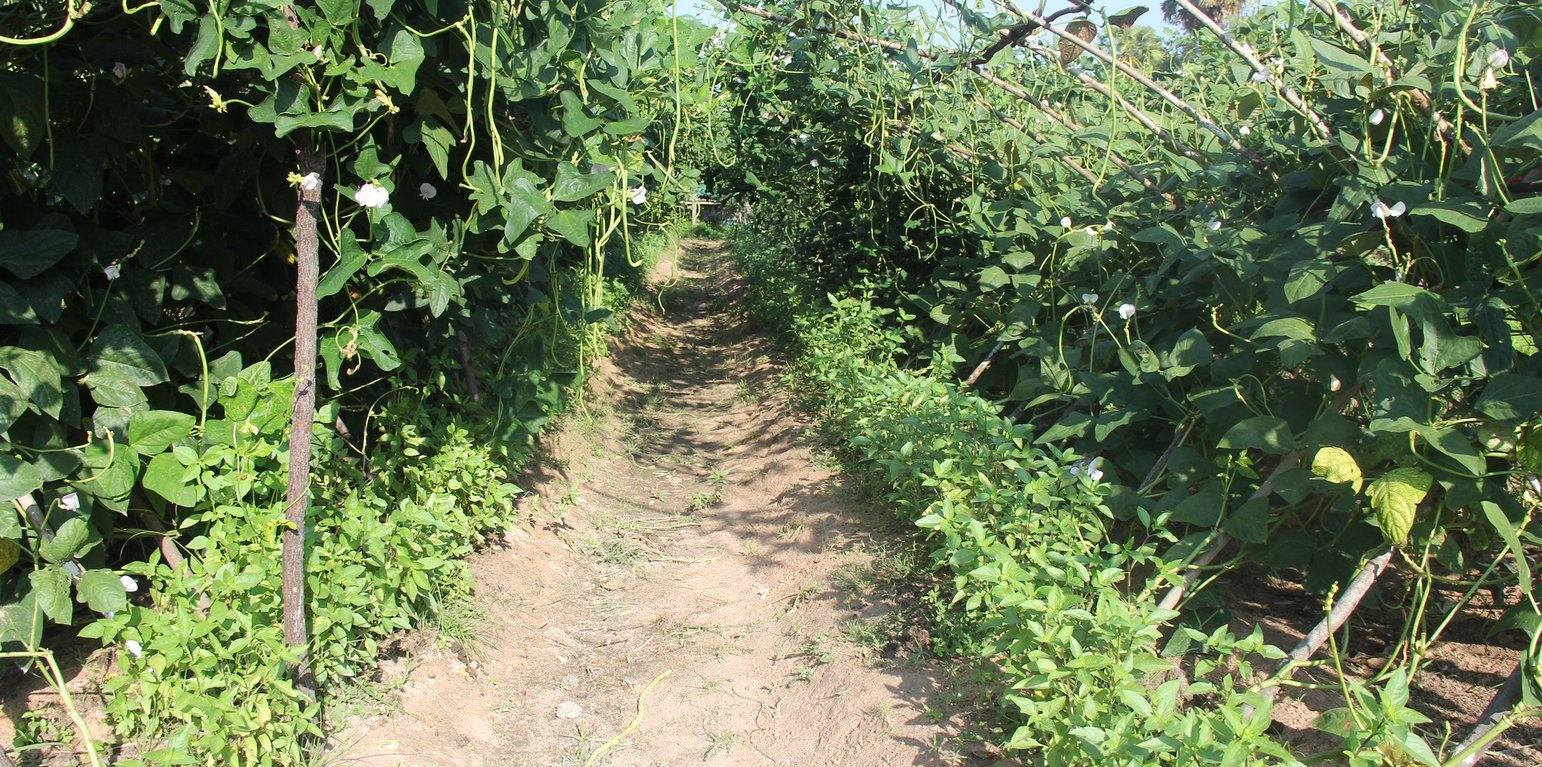



A sandy soil is a soil type with large particles that has difficulty in retaining both moisture and fertility, which makes it challenging for crop cultivation. Therefore, a practice is needed that helps farmer to improve the quality of such soils. Improving soil quality means to promote a process of constant improvement of soil fertility by maintaining soil moisture, reducing soil compaction, and support to better nutrient absorption, thereby finally promoting better plant growth. Sandy soils are relatively compact and can hamper the growth and penetration of plant roots, what hinders the absorption of nutrients. To reduce this effect, the incorporation of organic matter can be useful (Rhoades, 2016). The farmers have their own techniques to improve sandy soils; one example is the diversified crop cultivation by using natural fertilizer and liquid compost. This technology is applied by one of farmers in the Prey Puoch village, belonging to the Rolea B'ier District.
His objective was to improve sandy soils in order to achieve higher production. Apart of the application of liquid compost and natural fertilizers ‒ and consequently the improvement of the soil nutrient status ‒ the farmer also increased the range of crops to raise the production level. Therefore, the family was able to raise its surpluses to be sold at the markets significantly. This led to a meaningful improvement of the livelihood.
The farmer use only natural fertilizers, such as crops residue, and cow manure or manure from pigs, when cow manure is not available. Although pig manure does not contain the same high level of nutrients as cow manure, it helps to reduce soil compaction, allows crop’s roots to absorb nutrients, and improves soil moisture. In addition, liquid compost can be applied to increase soil fertility, as this kind of compost is rich in microorganisms that play an important role in the decomposition of organic materials. By this, nutrients can be provided in the best possible way. The farmer has planted long beans and other trellising plants in rotation and as inter-crops for example strongly smelling spring onion and anise basil. Such crops grown beneath the long beans can help to reduce pest damage and diminish the use chemical pesticides. Plating anise basil and spring onions along each long bean row and the rotation practices also help maintaining the nutrition level in the soil.
To make liquid compost the farmer uses two main ingredients, such as animal (poultry) manure and plant leaves (Siam weed, Cassia tree, Lead tree, Sesbania, etc.). All of the materials are chopped and mixed, and then put into a big jar with 20 times the volume of water being added. The jar is then closed to reduce the unpleasant smell. The mixture is stirred twice daily to provide enough oxygen for the microorganisms. After three weeks the liquid mixture will be no longer smelly, and will be ready for use as liquid compost. This compost is applied three times during the crop cycle: at the start of planting, just before the flowering stage, and at the production stage. The ratio of application is 1 liter of the liquid compost for each square meter of land (Yang and Pean, 2015).
Before the farmer adopted this technology they could not even grow water morning glory and they needed a lot of labor and much water for the irrigation. This practice not only helps to improve soil quality, it reduces also the costs by using less chemical fertilizers and pesticides, by reducing the labour input, and it helps to expand the area of arable land.
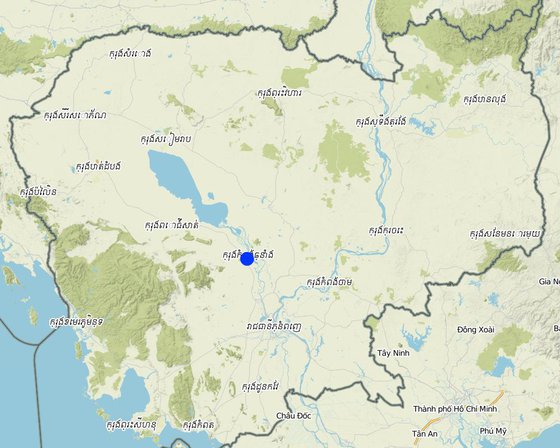
Location: Prey Puoch village, Chrey Bak commune, Rolea B'ier District, Kampong Chhnange province, Cambodia
No. of Technology sites analysed: single site
Spread of the Technology: evenly spread over an area (0.00036 km²)
In a permanently protected area?:
Date of implementation: 2016
Type of introduction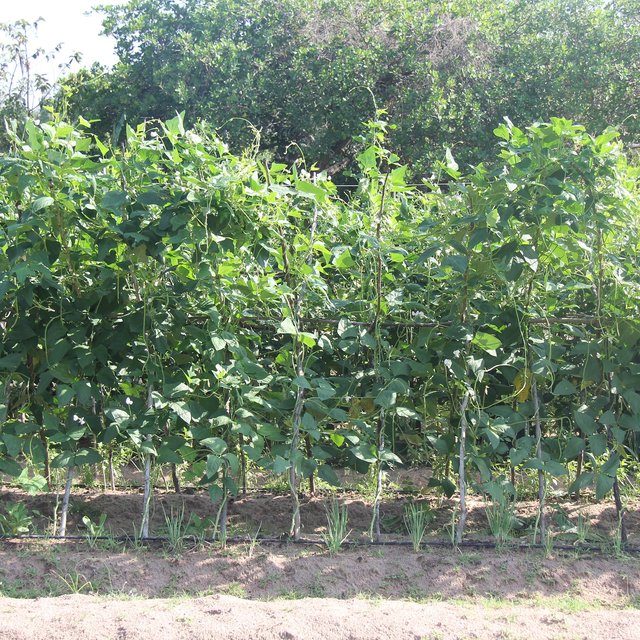
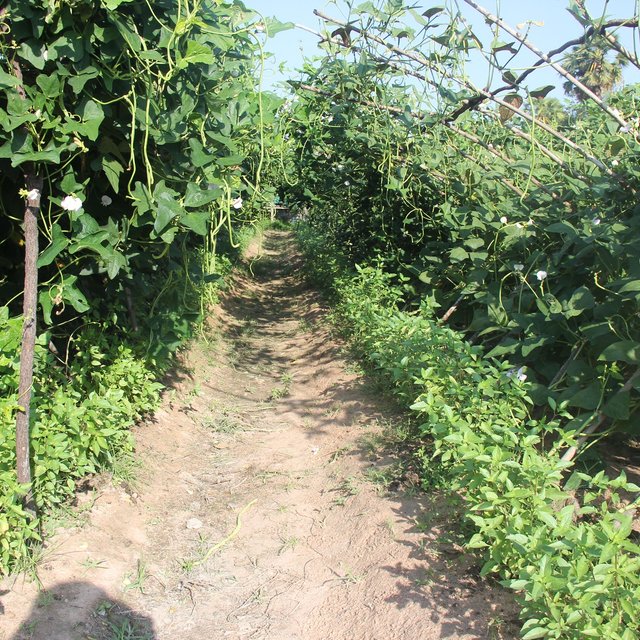





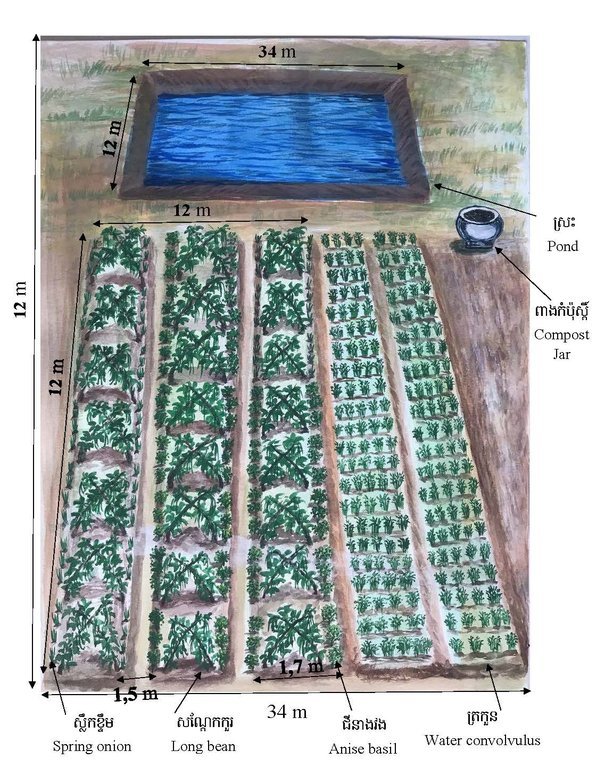
| Specify input | Unit | Quantity | Costs per Unit (KHR) | Total costs per input (KHR) | % of costs borne by land users |
| Labour | |||||
| Ploughing | times | 3.0 | 20000.0 | 60000.0 | 100.0 |
| Rows preparation and lime spreading | day | 2.0 | 25000.0 | 50000.0 | 100.0 |
| Preparing drip irrigation | day | 1.0 | 25000.0 | 25000.0 | 100.0 |
| Equipment | |||||
| Spade | piece | 1.0 | 15000.0 | 15000.0 | 100.0 |
| Hoe | piece | 1.0 | 20000.0 | 20000.0 | 100.0 |
| Shovel | piece | 1.0 | 20000.0 | 20000.0 | 100.0 |
| Plant material | |||||
| Long bean seeds | package | 1.0 | 10000.0 | 10000.0 | 100.0 |
| Spring onion seeds | kg | 3.0 | 4000.0 | 12000.0 | 100.0 |
| Tray seeding | piece | 6.0 | 4000.0 | 24000.0 | 100.0 |
| Fertilizers and biocides | |||||
| Cow manure | ox-driven vehicle | 6.0 | 20000.0 | 120000.0 | 100.0 |
| DAP fertilizer | kg | 5.0 | 3000.0 | 15000.0 | 100.0 |
| KCL fertilizer | kg | 5.0 | 3000.0 | 15000.0 | 100.0 |
| Urea fertilizer | kg | 5.0 | 3500.0 | 17500.0 | 100.0 |
| Construction material | |||||
| Drip system | set | 1.0 | 110000.0 | 110000.0 | 100.0 |
| Pipe | piece | 2.0 | 20000.0 | 40000.0 | 100.0 |
| Branches for trellising | piece | 225.0 | 300.0 | 67500.0 | 100.0 |
| Small water tank | piece | 2.0 | 6000.0 | 12000.0 | 100.0 |
| Total costs for establishment of the Technology | 633'000.0 | ||||
| Total costs for establishment of the Technology in USD | 158.25 | ||||
After using animal manure and compost
Soil is less compact and more rich in nutrients, which increases the production and therefore also the farm income.
More plant types can be planted, which diversifies the income sources.
Before the farm family was poorer, as they had difficulties to plant their sandy soil area. The improvement of this land improved also the livelihood of this family.
Reduced workload by using drip system and anise basil plantation, which reduces weed growing and pests.
By getting fresh vegetables and daily income
Never face with healthy
Are the same like before
After retired from government official, he just practices agriculture to reduce free time and to exercise.
Water quantity is enough for plantation.
No chemical fertilizer is applied, which results in better water quality.
Using drip irrigation system, which saves water.
More crop as soil cover to improve soil moisture. And the manure in the soil improves it too.
Before the soil was left uncultivated.
Reduced soil compaction by using animals manure and composting. This improves the soil structure.
Using animals manure and composting
Using animals manure and compost before each plantation time.
Before could not grow even water morning glory but now could grow many crops to reduced soil erosion.
Planting many crops and exchange crops types.
Using smelling crops such as anise basil. But it could be reduced only partly.
More earthworm in the soil
Could reduce some due to the smelling crops underneath.